1. Introduction
 Today we will be reviewing a graphics card from PowerColor, the ATI RADEON X1900 GT. PowerColor was established by Tul Corporation in 1997, and is one of the graphics industry's leading brand names and well known for its outstanding performance and innovative technology. As a leading provider of graphics cards, PowerColor offers powerful, reliable and cost-effective solutions to customers worldwide. PowerColor is the platform of choice for avid PC gamers and video prosumers looking to get the best possible performance out of the latest graphics processors from ATI.
Today we will be reviewing a graphics card from PowerColor, the ATI RADEON X1900 GT. PowerColor was established by Tul Corporation in 1997, and is one of the graphics industry's leading brand names and well known for its outstanding performance and innovative technology. As a leading provider of graphics cards, PowerColor offers powerful, reliable and cost-effective solutions to customers worldwide. PowerColor is the platform of choice for avid PC gamers and video prosumers looking to get the best possible performance out of the latest graphics processors from ATI.

-Features and specs according to PowerColor
| Model |
X1900GT |
Graphics Engine |
ATI Radeon X1900 |
| Video Memory |
256MB DDR3 |
Engine Clock |
575MHz |
Memory Clock |
600 MHz x 2 |
RAMDAC |
400MHz |
Bus Standard |
16 lanes PCI Express |
Memory Interface |
256-bit |
Max. Resolution |
2048 X 1536 |
Output |
Dual DVI/ / / VIVO/ HDTV |
Pixel Pipelines |
36 Pixel Processors |
| Direct X Support |
9.0 |
| TV Connector |
S-Video |
The X1900GT 256MB VGA card, uses a fan cooling system. Speeds are 575 MHz for the core and 1.2 GHz for the memory, which are ATI's default clocks, so no manufacturer overclocking has been incorporated into this model. Below is a table with the default ATI clocks for the X1900 series...
| |
Core
Speed
|
Memory
Speed
|
Pixel Shader
Processors
|
Vertex
Shader
|
| Radeon X1900 XTX |
650 MHz |
1.55 GHz |
48 |
8 |
| Radeon X1900 XT |
625 MHz |
1.45 GHz |
48 |
8 |
| Radeon X1900 CrossFire Edition |
625 MHz |
1.45 GHz |
48 |
8 |
| Radeon X1900 GT |
575 MHz |
1.2 GHz |
36 |
8 |
- Radeon® X1900 - Overview, as seen on the ATI website
Radeon® X1900 Series — The World’s Fastest Consumer Graphics
Is your rig ready for the onslaught of next generation games? It will be with the Radeon® X1900—the fastest consumer 3D graphics processor on the planet. Designed from the ground up to deliver maximum graphical detail at the best possible frame rates, the Radeon X1900’s state-of-the-art architecture includes an ultra-threaded engine for unparalleled shader performance. In addition, it is CrossFire™ ready, allowing your greatest multi-GPU fantasies to come true. The Radeon X1900 ups the ante with Avivo™ video and display technology delivering movies, games, and photos in high-definition format with stunning color and realism. The World’s Fastest Consumer Graphics Processing Unit (GPU)
The Radeon X1900 conquers the competition with brute force and massive parallelism, including an ultra-threaded engine, high speed memory support, and 90 nanometer technology.
- New ultra-threaded engine cranks up performance for a significant improvement over our previous generation GPU
- Ultra-efficient memory controller squeezes out every last drop of visual detail from your games
- 90 nanometer technology = maximum performance
Are You Ready to Slide Your Graphics Settings to ‘V. High’?
The Radeon X1900 promises the world’s fastest shader performance in Shader Model 3.0 applications. ATI allows you to experience simultaneous HDR and advanced anti-aliasing effects for incredible enhancements to lighting contour and colour details, delivering the ultimate in visually immersive 3D gaming.
- Get your box geared up for the future of games with blazing fast shader performance and watch your characters sweat with Shader Model 3.0
- Take the edge off of jagged wires and strands of hair with advanced adaptive anti-aliasing, and experience realistic lighting through HDR technology
- Unite the power of two graphics cards to accelerate your games even further with CrossFire, our acclaimed multi-GPU solution
Beyond games
There’s more to PC graphics than games, and Avivo — video and display perfection — makes sure you experience it all. Avivo promises a high definition amphitheatre visual experience, delivering sharper photos, smoother video, true-to-life image representation, and universal display connectivity.
- High-definition images come to life with remarkable clarity and over 1 billion colors
- Avivo’s universal connectivity allows you to create your ideal display set-up
- Avivo uses the same technologies present in digital TVs to deliver HD image quality for a high-end home theatre experience
- Packaging/Bundle

The retail box bundles all required cables, adapters and drivers, while it also offers DVD software for creating or watching DVD movies. However, no games are included.
Accessories:
- Quick Installation Guide
- Driver CD
- S-Video Cable
- 2x DVI to VGA adaptor
- HDTV Cable
- Composite Cable
- VIVO Cable
- PCI-E Power Cable
- Bundled DVD Software
- PowerDirector SE+
- MediaShow SE
- PowerDVD
- PowerProducer DVD
- Power2Go
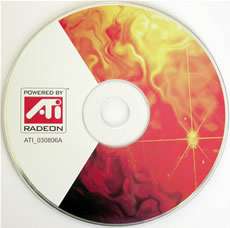 |
 |
| Driver CD |
DVD Software |
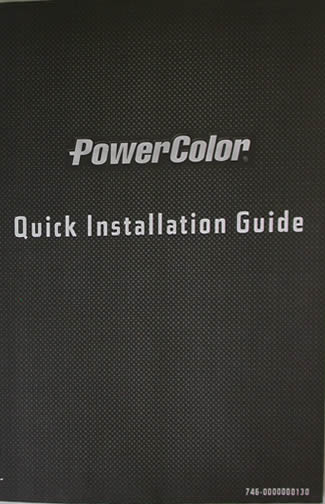 |
| Quick Installation Guide... |
 |
| VIVO and HDTV cable... |
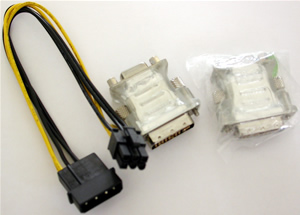 |
| Power Cable and 2xDVI2VGA adaptors... |
 |
| S-Video and Composite Cable... |
Now that we have covered the card's features, let's move on the next page and have a closer look.
2. A Closer Look

 |
| Click on the image for a larger photograph |
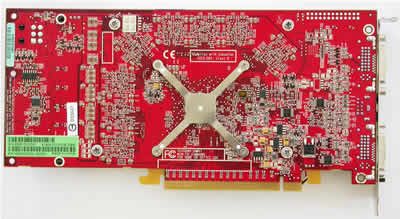 |
| Click on the image for a larger photograph |
The PowerColor X1900 GT is CrossFire enabled, which means that if you add a CrossFire Master card, it can work in CrossFire mode giving higher performance.
|
| A Closer look at the cooler's artwork... |
|
| A Closer look on the card's fan... |
|
| The R580 chip is the second generation 90 nanometer GPU from ATI. |
|
Samsung memory modules...
|
The PowerColor X1900 GT offers dual DVI-I connectors and an S-Video TV-out connection...

On the back, you will find the standard PCI-E power connector, which requires at least a 450-Watt power supply.

OK, let's move on to the tests and testbed system.
3. Test System - Configuration
For our review, we setup the following testbed:
- Processor: AMD64 3500+ NewCastle (939 socket)
- Case: Antec 1080AMG
- Motherboard: ASUS A8N32-SLI Deluxe
- Memory: 2x512MB Corsair XMS TWINX1024-3200XL Memory
- Hard Disk Drive: WD800JD 80GB 7200RPM
- DVD Burner: Pioneer DVR-A08XLA
- Power Supply: EzCool 550Watt, Thermaltake Power Express 250W
- OS: Microsoft WindowsXP Pro SP2
- DirectX: v9.0c
- ATI Catalyst & Control Center: 6.4

Benchmarking Software:
- 3DMark06,05,03,01
- Codecreatures Benchmark Pro
- AquaMark3 v3.0
- Half Life 2
- Quake 4
- Ground Control II
- F.E.A.R.
- Need For Speed: Most Wanted
For comparison, we will be posting the results of the PowerColor X1900 GT 256M along with the results of the ASUS EAX1600XT SILENT, XFX 7800 GTX and ASUS N7800 GTX TOP.
4. 3DMark2006
 The 3DMark06 raises the bar for DirectX performance analysis with new and improved graphics tests relying on more complex shaders, all new CPU tests with demanding physics and AI that support single or multiple core and multiple processor systems.
The 3DMark06 raises the bar for DirectX performance analysis with new and improved graphics tests relying on more complex shaders, all new CPU tests with demanding physics and AI that support single or multiple core and multiple processor systems.
3D Mark06 is the worldwide standard in advanced 3D game performance benchmarking. A fundamental tool for every company in the PC industry as well as PC users and gamers, 3DMark06 uses advanced real-time 3D game workloads to measure PC performance using a suite of DirectX 9 3D graphics tests, CPU tests, and 3D feature tests. 3DMark06 tests include all new HDR/SM3.0 graphics tests, SM2.0 graphics tests, AI and physics driven single and multiple cores or processor CPU tests and a collection of comprehensive feature tests to reliably measure next generation gaming performance today.
SM2.0 Graphics Test 1 -Return to Proxycon
 Using an updated game engine, this 3rd person shooter emulation makes use of very complex SM2.0 shaders. Large interior spaces accommodate more characters for lots of action. With 26 total lights, 2 are directional with one casting CSM (Cascading Shadow Maps), 12 point lights provide fill, most cast shadows using 1024x1924x6 cube depth maps and hardware shadows, some are masked and animated, and finally 12 small spot lights with non-overlapping shadow-maps produce a richly lit and shadowed game scene. Blinn-Phong reflections using lookups are applied to the ship surfaces.
Using an updated game engine, this 3rd person shooter emulation makes use of very complex SM2.0 shaders. Large interior spaces accommodate more characters for lots of action. With 26 total lights, 2 are directional with one casting CSM (Cascading Shadow Maps), 12 point lights provide fill, most cast shadows using 1024x1924x6 cube depth maps and hardware shadows, some are masked and animated, and finally 12 small spot lights with non-overlapping shadow-maps produce a richly lit and shadowed game scene. Blinn-Phong reflections using lookups are applied to the ship surfaces.
SM2.0 Graphics Test 2 - Firefly Forest
 Again, an updated game engine plays critically in this SM2.0 shader rich fantasy game scene. The large outdoor scene is dense with vegetation and grass is dynamically distributed and altered according to the camera's location. Surrounded by a skybox, multiple glowing, illuminated fireflies flit about among animated trees, branches and leaves. This test dramatically highlights the benefits of Cascading Shadow Maps and high resolution shadow-mapped point lights. The scene is lit with 1 directional light casting CSM to create a moonlight effect. The 2 illuminated fireflies are shadow-mapped point lights with cube-map masks. A procedural light scattering shader is used for the humid night time sky. Materials have Blinn-Phong reflections using lookups for materials. The ground material has diffuse, diffuse detail, normal and normal details maps added. Rock surfaces have an added specular map. Tree branches are similar to the rock materials but with an added diffuse cube map and no specular or bump map.
Again, an updated game engine plays critically in this SM2.0 shader rich fantasy game scene. The large outdoor scene is dense with vegetation and grass is dynamically distributed and altered according to the camera's location. Surrounded by a skybox, multiple glowing, illuminated fireflies flit about among animated trees, branches and leaves. This test dramatically highlights the benefits of Cascading Shadow Maps and high resolution shadow-mapped point lights. The scene is lit with 1 directional light casting CSM to create a moonlight effect. The 2 illuminated fireflies are shadow-mapped point lights with cube-map masks. A procedural light scattering shader is used for the humid night time sky. Materials have Blinn-Phong reflections using lookups for materials. The ground material has diffuse, diffuse detail, normal and normal details maps added. Rock surfaces have an added specular map. Tree branches are similar to the rock materials but with an added diffuse cube map and no specular or bump map.
HDR/SM3.0 Graphics Test 1 - Canyon Flight
 The updated game engine supports extremely complex SM3.0 shaders in this test for exquisite HDR (High Dynamic Range) rendering effects, as well, highlighting the benefit of dynamic shadows. This period style adventure game scene makes extensive use of smooth shadows. A massively complex outdoor canyon and seascape is rendered in very realistic HDR using floating point calculations. Sky and atmospheric effects rely on a complex atmospheric light scattering algorithm with cloud blending; adding great depth to distant scene elements. A heterogeneous fog effect creates deep humidity throughout the canyon. Water material is a further developed 3DMark05 water shader. Water effects are recreated using HDR reflections and refractions, plus a depth fog is used below the surface, and the water surface is distorted with 2 scrolling maps and Gerstner wave functions. Smoke and fire particle effects emanate from the airship. Subsurface scattering and a Blinn-Phong shading model with 2 normal maps and 1 color map are used for the sea-monster. Strauss shading is used for the captain, crew and airship. The canyon wall material uses 3 color maps, 3 normal maps and Lambertian diffuse shading. One directional light, casting CSM is used to create the bright sunlight, producing dramatic dynamic shadows, while showcasing the challenging effect of dynamic shadows on large round shapes.
The updated game engine supports extremely complex SM3.0 shaders in this test for exquisite HDR (High Dynamic Range) rendering effects, as well, highlighting the benefit of dynamic shadows. This period style adventure game scene makes extensive use of smooth shadows. A massively complex outdoor canyon and seascape is rendered in very realistic HDR using floating point calculations. Sky and atmospheric effects rely on a complex atmospheric light scattering algorithm with cloud blending; adding great depth to distant scene elements. A heterogeneous fog effect creates deep humidity throughout the canyon. Water material is a further developed 3DMark05 water shader. Water effects are recreated using HDR reflections and refractions, plus a depth fog is used below the surface, and the water surface is distorted with 2 scrolling maps and Gerstner wave functions. Smoke and fire particle effects emanate from the airship. Subsurface scattering and a Blinn-Phong shading model with 2 normal maps and 1 color map are used for the sea-monster. Strauss shading is used for the captain, crew and airship. The canyon wall material uses 3 color maps, 3 normal maps and Lambertian diffuse shading. One directional light, casting CSM is used to create the bright sunlight, producing dramatic dynamic shadows, while showcasing the challenging effect of dynamic shadows on large round shapes.
HDR/SM3.0 Graphics Test 2 - Deep Freeze
 With HDR rendering and SM3.0 shaders, this test emulates a movie-like horror adventure scene and showcases CSM with dynamic long, soft shadows for a striking daytime to nighttime transition. As the sun sets, shadows dynamically increase in length for a very realistic effect. For the snow storm, heterogeneous fog and particles with an added diffuse cube map are used. A simple atmospheric light scattering algorithm is used for the sky. A Blinn-Phong shader with 2 normal maps, 1 color map and subsurface scattering is used for the snow material. Metallic and other surfaces use the Strauss shading model. 1 directional light casting CSM recreates the sunlight. By blending 2 pairs of cube-maps, (1 diffuse, 1 specular) and ambient effect is created. HDR values requiring floating point rendering hover to approximately 11.000.
With HDR rendering and SM3.0 shaders, this test emulates a movie-like horror adventure scene and showcases CSM with dynamic long, soft shadows for a striking daytime to nighttime transition. As the sun sets, shadows dynamically increase in length for a very realistic effect. For the snow storm, heterogeneous fog and particles with an added diffuse cube map are used. A simple atmospheric light scattering algorithm is used for the sky. A Blinn-Phong shader with 2 normal maps, 1 color map and subsurface scattering is used for the snow material. Metallic and other surfaces use the Strauss shading model. 1 directional light casting CSM recreates the sunlight. By blending 2 pairs of cube-maps, (1 diffuse, 1 specular) and ambient effect is created. HDR values requiring floating point rendering hover to approximately 11.000.

The X1900 GT reported similar framerates to the XFX 7800 GTX, while the ASUS 7800 GTX TOP performed best, producing in almost all tests, the highest framerate.
Final Score

And as expected, the ASUS 7800 GTX TOP achieved the highest score. The X1900 GT was just 100 marks behind the XFX 7800 GTX.
5. 3DMark2005
 The 3DMark05 is best suited for the latest generation of DirectX®9.0 graphics cards. It is the first benchmark to require a DirectX9.0 compliant hardware with support for Pixel Shaders 2.0 or higher! By combining high quality 3D tests, CPU tests, feature tests, image quality tools, and much more, 3DMark05 is a premium benchmark for evaluating the latest generation of gaming hardware.
The 3DMark05 is best suited for the latest generation of DirectX®9.0 graphics cards. It is the first benchmark to require a DirectX9.0 compliant hardware with support for Pixel Shaders 2.0 or higher! By combining high quality 3D tests, CPU tests, feature tests, image quality tools, and much more, 3DMark05 is a premium benchmark for evaluating the latest generation of gaming hardware.
Game Test 1 -Return to Proxycon
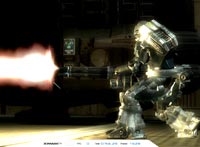 Being the sequel to the "Battle of Proxycon" from 3DMark03, in "Return to Proxycon" we're once again set in space and the battle continues as space pirates invade a cargo ship in order to take control of its valuable cargo.
Being the sequel to the "Battle of Proxycon" from 3DMark03, in "Return to Proxycon" we're once again set in space and the battle continues as space pirates invade a cargo ship in order to take control of its valuable cargo.
This test, tries to simulate a future first-person shooter game with all the high details that entails. The dynamic shadows, high-detailed environment and advanced lighting techniques ensure that under normal circumstances, no recent card can run it with decent frame rates.
Game Test 2 - Firefly Forest
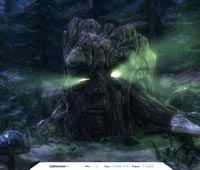 A forest gets filled with magic fireflies in the night. The moon is nearly full, illuminating the forest with a bluish faint light. The magic fireflies have flickering bright green lights that playfully move around the forest.
A forest gets filled with magic fireflies in the night. The moon is nearly full, illuminating the forest with a bluish faint light. The magic fireflies have flickering bright green lights that playfully move around the forest.
This scene is a nice example of a smaller scale outdoor scene with rich vegetation. Immediate visibility is not so far, and there is a skybox surrounding the whole scene.
A large number of trees with their branches swinging separately, and dense vegetation being dynamically distributed according to the camera movements, make this test the most demanding of the three.
Game Test 3 - Canyon Flight
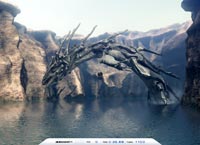 A Jules Verne type airship flies through a canyon guarded by a dangerous sea monster. The airmen defend their ship using heavy cannons, but these seem to have no effect on the huge sea monster. Finally the crew manages a narrow escape using the "last resort" afterburners of the airship.
A Jules Verne type airship flies through a canyon guarded by a dangerous sea monster. The airmen defend their ship using heavy cannons, but these seem to have no effect on the huge sea monster. Finally the crew manages a narrow escape using the "last resort" afterburners of the airship.
This scene is fairly complex with large areas of water reflecting the high canyon walls. The water actually is one of the key points of interest in this scene. The water not only does realistic looking reflections and refractions, it has a depth fog, making the sea monster swimming under the airship actually look deep down in the water. The air in this scene also uses a volumetric fog, making distant cliffs of the canyon really look far away.

Different outcome in comparison to the 3D Mark06 benchmark. This time, the X1900 GT reported the highest framerates 2 out of 3 tests.
Final Score

And the final score puts the PowerColor X1900 GT on top, while both nVidia cards follow close behind.
6. 3DMark2003
 3D Mark is a widely used and accepted benchmark that stresses the DirectX performance of a VGA card. A very strong point of 3DMark is that it's VGA card measuring is does not require any CPU power. So the resulting fps are a good reference a VGA card's rendering performance. For testing the performance of each card we used the 4 game benchmarks 3DMark has.
3D Mark is a widely used and accepted benchmark that stresses the DirectX performance of a VGA card. A very strong point of 3DMark is that it's VGA card measuring is does not require any CPU power. So the resulting fps are a good reference a VGA card's rendering performance. For testing the performance of each card we used the 4 game benchmarks 3DMark has.
3Dmark03 also includes sound and CPU tests as well as some other feature tests.
- Game Test 1 - Wings of Fury (DX7)
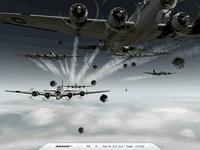
This test is a combat flight simulator written for older hardware (DirectX 7). Particles are used a lot in this test - smoke and vapor trails, flak and gunfire, and explosions are produced using point sprites and quads.
- Game Test 2 - Battle of Proxycon (DX8)
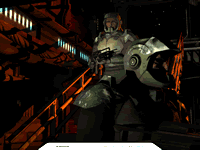
This test is a simulation of first person shooter game types. 1.1 and 1.4 Vertex shaders are widely used since all character models are skinned using vertex shaders.This makes this test a good vertex shader comparison for VGA cards.
- Game Test 3 - Trolls' Lair (DX8)
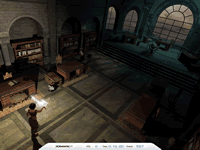
This test should be the favorite of all RPG lovers. It is a cut scene of a female warrior facing two malicious trolls. Again the same vertex and pixel processing is used as in game test 2.
This test also uses post-processing effects, such as Depth of Field and Bloom effects which are widely used in today's game cut scene sequences.
- Game Test 4 - Mother Nature (DX9)
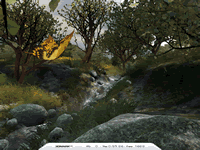
Mother nature represents the level of effects and realism that are possible using 2.0 vertex and pixel shaders, plus some other features that DirectX 9 offers.
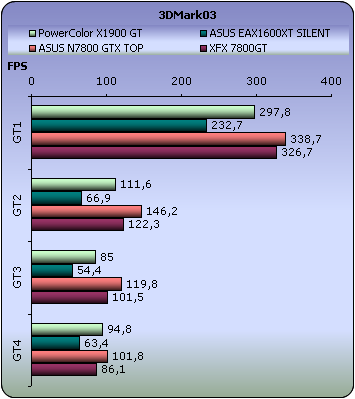
Once again, different results here. With 3D Mark05, the X1900 GT produced better performance than the nVidia cards, but in 3D Mark03, both Nvidia cards show their power, producing higher framerates in all tests.
- 3DMark Official score
If you test your machine with 3DMark, you can post the results at 3DMark's online result browser. For more information visit futuremark.com.
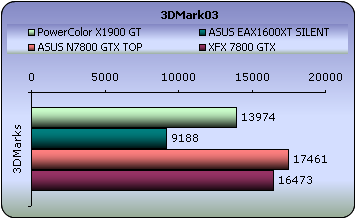
The final score more or less agrees with that of 3D Mark 06, which sets the nVidia cards on top.
7. Codecreatures
 CodeCreatures is a synthetic 3D benchmark that is a good reference for VGA performance comparison. This is a high-end 3D benchmark that also requires DirectX 8 hardware, making a good tool for measuring the potential of DirectX 8 game performance.
CodeCreatures is a synthetic 3D benchmark that is a good reference for VGA performance comparison. This is a high-end 3D benchmark that also requires DirectX 8 hardware, making a good tool for measuring the potential of DirectX 8 game performance.
The Codecreatures benchmark is written with Microsoft's DirectX 8.1 API and incorporates the use of Vertex and PixelShaders popular on next generation 3D accelerators.

The benchmark plays a photo-realistic nature scene and calculates the performance of the graphics adapter by measuring the fps that it can display at 1024x768, 1280x1024 and 1600x1200 resolutions.
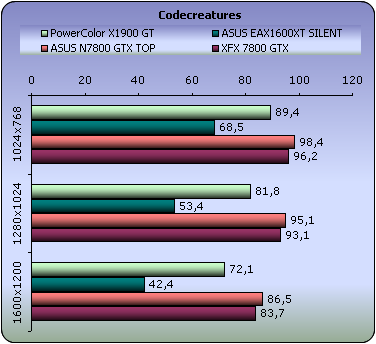
-Codecreatures number
The codecreatures number is the resulting score of the total benchmarking process and is basically the geometric mean of the three frame rates multiplied by 100.

Similar outcome to what we saw with the 3D Mark03 and 3D Mark06 benchmarks, with the nVidia cards achieving the higher framerates and final scores.
8. Aquamark - 3DMark01
 Since the majority of today's applications and games are compatible with DirectX 9, the need of benchmark applications that use DX 9 has been brought up. The benchmark uses the 3D engine (Krass engine) of the Aquanox game.
Since the majority of today's applications and games are compatible with DirectX 9, the need of benchmark applications that use DX 9 has been brought up. The benchmark uses the 3D engine (Krass engine) of the Aquanox game.
Aquamark Triscore
The Aquamark Triscore comprises 3 values: the overall system performance, the performance of the graphics system and the CPU performance. Keep in mind that this is not the total result of the tests, but the result of the whole benchmark process including all 9 chapters.
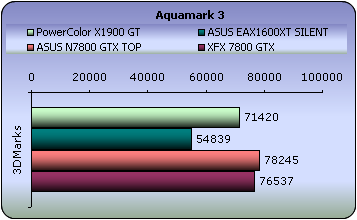
Once again, the nVidia cards take over the top positions.
3DMark 2001
 is the predecessor to 3DMark03. It's mainly a directx8.1 benchmark and the score depends a lot on the CPU power of your computer. However for reference use only we decided it'd be best to just leave it in our benchmark list so you can compare the next generation cards with the possibly outdated you have at home.
is the predecessor to 3DMark03. It's mainly a directx8.1 benchmark and the score depends a lot on the CPU power of your computer. However for reference use only we decided it'd be best to just leave it in our benchmark list so you can compare the next generation cards with the possibly outdated you have at home.

The interesting thing is that not just the order, but also the difference between the cards is almost standard with most of the benchmarks. The ASUS N7800 GTX TOP is clearly the most powerful card with the XFX 7800GT close behind. The PowerColor X1900 GT is a little further behind and the ASUS EAX1600XT SILENT trails by a difference.
9. Half Life 2
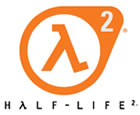
Half life 2 is no doubt the most anticipated pc game of all times.
 Characters - Advanced facial animation system delivers the most sophisticated in-game characters ever seen. With 40 distinct facial "muscles," human characters convey the full array of human emotion, and respond to the player with fluidity and intelligence.
Characters - Advanced facial animation system delivers the most sophisticated in-game characters ever seen. With 40 distinct facial "muscles," human characters convey the full array of human emotion, and respond to the player with fluidity and intelligence.
Physics - From pebbles to water to 2-ton trucks respond as expected, as they obey the laws of mass, friction, gravity, and buoyancy.
 Graphics - Source's shader-based renderer, like the one used at Pixar to create movies such as Toy Story® and Monster's, Inc.®, creates the most beautiful and realistic environments ever seen in a video game.
Graphics - Source's shader-based renderer, like the one used at Pixar to create movies such as Toy Story® and Monster's, Inc.®, creates the most beautiful and realistic environments ever seen in a video game.
AI - Neither friends nor enemies charge blindly into the fray. They can assess threats, navigate tricky terrain, and fashion weapons from whatever is at hand.
To measure performance we used the Video Stress Test(VST) that is available in the CounterStrike:Source beta available through Steam. We set all the details to the highest level and each time changed the resolution from 800x600 up to 1600x1200.

Since the game is very CPU dependent, we can almost ignore results taken at resolutions of 800x600 and 1024x768. The true value of a VGA card is best seen at the highest resolutions with HL2. That is, at 1280x1024 and at 1600x1200 gaming resolutions.
The X1900 GT reported similar framerates to the XFX 7800 GTX at all tested resolutions, while the 7800 GTX TOP continues to provide the highest performance.

However, when AA and AF are enabled, the PowerColor card just doesn't have the horsepower to keep up and falls behind the XFX 7800 GTX at the higher resolutions.
10. Ground Control II
 Ground Control 2 is an action-oriented game of tactics and warfare. As Captain Jacob Angelus of the Northern Star Alliance, you will command squads of infantry, artillery, and air power against the might of the Empire of Terra. Base building and resource-collecting are replaced with unit control and combat tactics where your knowledge of the battlefield maneuvers will make the difference in your fight against a ruthless enemy. Position your troops on hilltops for better aim or inside buildings and forests for protection as you'll need to use every inch of terrain to your advantage.
Ground Control 2 is an action-oriented game of tactics and warfare. As Captain Jacob Angelus of the Northern Star Alliance, you will command squads of infantry, artillery, and air power against the might of the Empire of Terra. Base building and resource-collecting are replaced with unit control and combat tactics where your knowledge of the battlefield maneuvers will make the difference in your fight against a ruthless enemy. Position your troops on hilltops for better aim or inside buildings and forests for protection as you'll need to use every inch of terrain to your advantage.
For our benchmarks, we used the highest possible settings on the first mission of the single player game and moved around the camera to get an average frame rate using fraps.

Ground Control II offers really impressive graphics without requiring much GPU power.

Both Nvidia cards maintain a constant framerate across all resolutions, while the other two cards, drop off as the resolution rises.

With AA and AF enabled, performance is noticeably affected, dropping to almost half for the X1900 GT, while the NVidia cards only really fade away a bit at 1600x1200.

11. Quake 4
 In a desperate war for Earth's survival, against an unrelenting alien enemy, the only way to defeat them is to become one of them. Armed with advanced weaponry and vehicles and aided by an elite squad of marines, you take the battle to the heart of the Strogg home planet and become Earth's only hope for victory.
In a desperate war for Earth's survival, against an unrelenting alien enemy, the only way to defeat them is to become one of them. Armed with advanced weaponry and vehicles and aided by an elite squad of marines, you take the battle to the heart of the Strogg home planet and become Earth's only hope for victory.
Quake 4 is a First Person Shooter developed by Ravensoft, based on the Doom 3 engine, and the graphics and gameplay certainly reflect that fact. For those who really hated the one-way corridors of Doom 3, new outdoor areas have been added to the game. The feeling however, still remains the same as these areas are quite small-scale, contrary to what other games have to offer.
- Benchmark Settings

As Quake 4 includes no default benchmark, we decided to go with another publicly available demo to measure performance. What we chose is a demo from HWSpirit, which involves a small outdoor scene followed by a long indoor combat. As preloading the stage once again failed miserably and the average framerate varied a lot, we ran it twice every time we restarted the game and measured only the second run.

The resolutions we used are 800x600, 1024x768, 1280x1024 and 1600x1200. We measured performance with and without Anti-aliasing.

Quake4 uses the Doom3 engine, which is known to prefer nVidia based cards, so it was quite natural to see the N7800 GTX and 7800 GT cards offering better performance overall. Again notice, that they maintain a constant framerate across resolutions.

The scene doesn't change with the AA and AF enabled, other than lower framerates at the higher resolutions.

12. Need For Speed - Most Wanted
 Wake up to the smell of burnt rubber as the thrill of illicit street racing permeates into the air.
Wake up to the smell of burnt rubber as the thrill of illicit street racing permeates into the air.
Combining illicit street racing and tuner customization with the intensity of strategic police pursuit that surpasses any Hollywood-style chase scene, Need for Speed Most Wanted will be on every gamer's 'must-have' list this holiday season. Out-race rivals, evade cops and exploit hundreds of miles of open road as gamers make their way up the Blacklist.
To become the most wanted racer, players must build up their street cred and Rap Sheet with gripping, white knuckle, head-to-head races with the top drivers on the streets, as well as pull daring, evasive moves to out-run and out-fox the cops that patrol the open road. Players can manage their heat or utilize a number of strategic tactics to keep the cops off their tails as they leave their rivals behind to suck their exhaust fumes.

- Benchmark Settings
NFS Most Wanted does not include a default benchmark. To measure the card's performance, we've chosen to record the framerate at the start of a circuit race with end-game cars. The starting point tends to be one of the most graphically demanding sections because of the smoke created by spinning wheels added to the rest of the game's visual effects. If a card can pass this stage with an acceptable framerate, it is a guarantee that it will face no problems with the rest of the game.
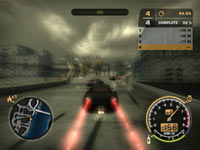
The resolutions we used are 800x600, 1024x768, 1280x1024 and 1600x1200. We measured performance at the lowest and highest possible settings.

In NFS Most Wanted, the ATI X1900 GT performed quite well, producing higher framerates than the 7800 GTX TOP and almost similar framerate to the XFX 7800 GTX.
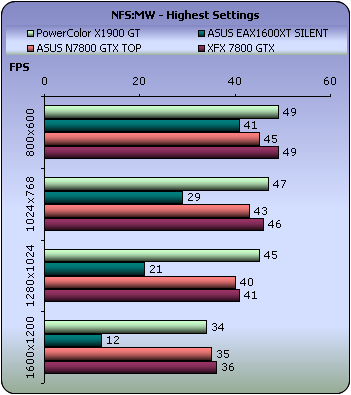
With AA and AF enabled, the results are a little mixed. At 1280x1024, the X1900 GT clearly had the highest framerate, while at 1600x1200, the three top cards have very little between them.
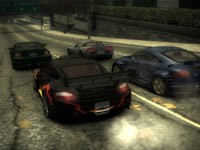
13. F.E.A.R.
 You aren't a soldier. You are a weapon. A paramilitary force infiltrates a multi billion dollar aerospace compound taking hostages, but issuing no demands.
You aren't a soldier. You are a weapon. A paramilitary force infiltrates a multi billion dollar aerospace compound taking hostages, but issuing no demands.
The government responds by sending in its best special operations teams, only to have them obliterated. Live footage of the massacre is cut short by an unexpected wave of destruction that leaves military leaders stunned and in disbelief.
First Encounter Assault Recon (F.E.A.R.) is one of the new-generation FPS. The graphics are really stunning, the plot behind the whole shooting successfully keeps it interesting and even the A.I. seems to work well.
F.E.A.R. offers a lot to the First Person Shooter world. The graphics are very clear with excellent textures, great new effects that will stress your graphics card and rag-doll physics that are waiting to be exploited as you progress through the game.
- Benchmark Settings
F.E.A.R. allows you to test the video settings with a mini-benchmark involving a lot of weapon firing, explosions and several other effects. After the benchmark is run, you're presented with a screen showing your minimum, average and maximum framerates and also percentages of how often the framerate was below 25fps, between 25 and 40, and finally above 40. For presentation reasons, we're just sticking to the minimum and average framerates.
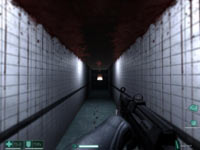
The resolutions we used are 800x600, 1024x768, 1280x1024 and 1600x1200. We measured performance with high and highest details.

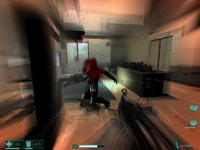

In F.E.A.R., the performance from the X1900 GT at high resolutions is quite good, producing framerates slightly lower than the XFX 7800 GTX.

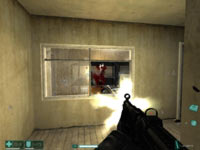

With the Highest settings enabled, the X1900 GT produced the highest average framerate at the higher resolutions, and was not that far behind top spot for minimum fps.

14. Overclocking
No matter your graphics card, there comes a time in your computer's life when it can no longer cope with the latest technological demands the ever so popular games impose. This is one of the main reasons for overclocking your graphics card. Gamers are always looking forward to a little extra boost in terms of framerate. Even though most of the time the boost is far from noticeable, overclocking remains the last resort when you can't afford to buy a brand new VGA card.
For the overclocking tests, we used an Intel based system, with an overclocked Intel 3.73 Extreme Edition. Below is a screenshot from the AiBooster utility.
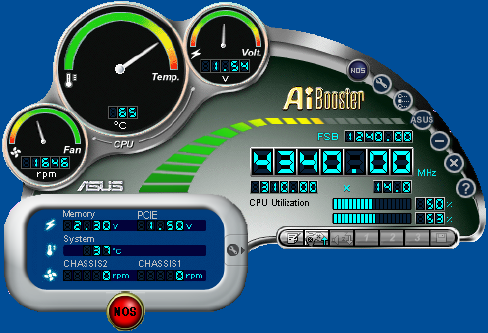
The stock clock speeds for the PowerColor X1900 GT that we received, were 574MHz for the core and 594MHz for the memory. Below are the screenshots, as seen from the ATI Overdrive Control Center.
We measured the temperature with the PC running no applications. The temperature was 54°C, which is close to the typical temperature that we had seen with other cards, even when running everyday applications in Windows. During the 3DMark05 benchmarks, the temperature climbed up to 76 °C, with default clock speeds of 574/594.
 |
 |
| IDLE temperature |
Gaming temperature |
To overclock the card, we ran the Automated Overdrive wizard from the ATI control center, which should find the best frequencies. The overclocked speed was very high for the core, with just an additional +17MHz. However, the +122MHz for the memory is a reasonable gain.

But we didn't stop there, pushing the core to 600MHz while still achieving a stable system, without artifacts. However, when we tried for an even higher core speed, at 620MHz, (which is almost the core clock speed of an X1900XT series card), the temperature during 3D mark05 was 88°C, with artifacts.
Below is the temperature, measured during 3D Mark05:
 |
| Overclocked 3D Mark05 temperature |
It seems that the cooling system wasn't designed for such overclocking speeds. 84°C is simply too high, although we believe that if the card was equipped with a better cooling system, there may have been a possibility of pushing it even further, since ATI chipsets are known for their good overclocking capabilities.
OK, let's see if overclocking the card achieved any difference in performance .

300 marks more in 3D Mark05 after overclocking...

The difference in NFS MW after overclocking was a mere 2 fps...


In F.E.A.R, the card produced between 2 and 5 fps higher performance.
In order to push the card even higher, we installed an alternative cooling solution, the Vcool VC3600.

We used this cooler because as we previously mentioned, the stock cooling system was limiting the card's overclocking limit.
And we were right. We achieved the clock speeds of an X1900XT series card.
 |
| Overclocked 3D Mark05 temperature |
While at the same time, keeping the temperature level significantly lower than the stock cooler.
15. Conclusion
 If you are looking for a high performance card at a reasonable price, that is able to cope with all of the latest generation games, then the PowerColor X1900 GT is one card you should consider.
If you are looking for a high performance card at a reasonable price, that is able to cope with all of the latest generation games, then the PowerColor X1900 GT is one card you should consider.
The card's performance was satisfactory in all the tested games, producing high framerates even at high resolutions with AA and AF enabled. In Half Life 2, F.E.A.R and NFS MW, the card performed more or less like the XFX 7800 GTX, which is an nVidia high-end and high priced card. In Ground Control 2 and Quake 4 with AA and AF, the card was just behind the XFX. These performances were confirmed with the 3D Mark06, 03, 01, Codecreatures and Aquamark 3 benchmarks, excepting 3D Mark05, which placed the card above the ASUS N7800 GTX TOP.

Overclocking capabilities are average. Leaving the stock GPU cooler in place, we managed to overclock the core from 574MHz to 600MHz and the memory from 594MHz to 716MHz, while only gaining a 1-5 fps boost in games. The stock cooler is also not designed for heavy overclocking, and temperature rose to 84°C, and 88°C when we set the core to 620MHz and memory to 720MHz. The clock speeds are close to those of an X1900XT card. We then changed the stock cooler with a VCool VC3600 and managed to achieve clock speeds of 625/720 while keeping temperatures respectable.
The retail package from PowerColor is complete, and includes all required cables, drivers and DVD software. However, no games are included.

At the time of this review, the PowerColor was priced at US $299.99 from newegg.com, quite reasonable for such a high performance card.
Pros:
- High performance
- Low price
- DVD Software
Cons:
- Average cooling system
- No bundled games

| Performance: |
 |
| Overclocking: |
 |
| Bundle: |
 |
| Value for money: |
 |